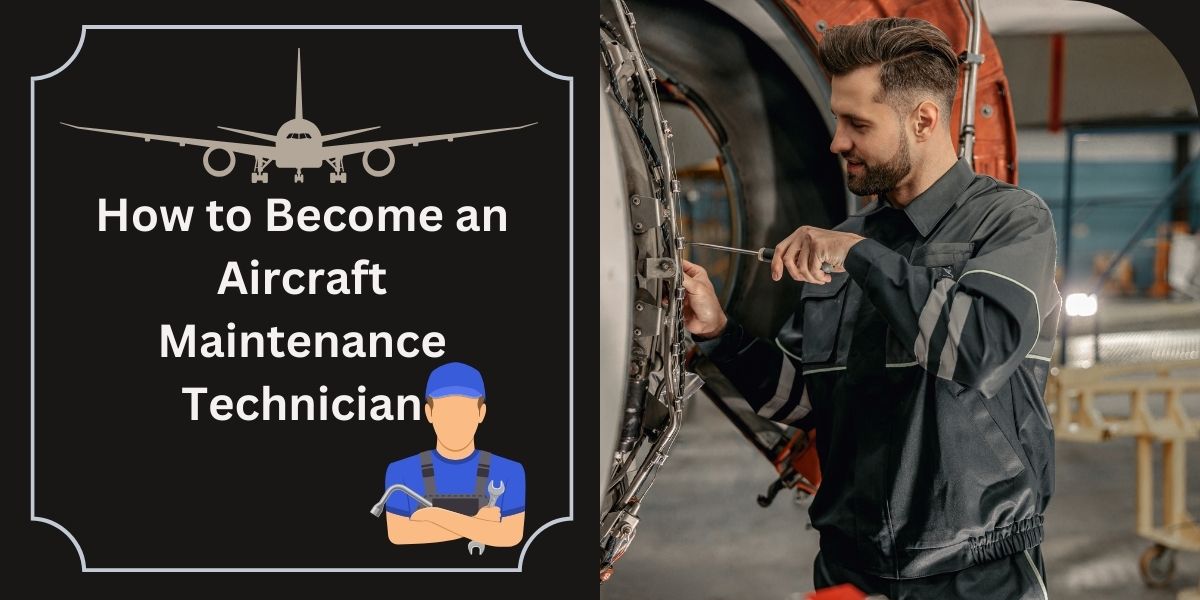Embarking on the journey to become an Aircraft Maintenance Technician (AMT) is like launching into a career that keeps planes flying smoothly.
Aircraft maintenance technicians (AMTs) are responsible for ensuring the safety and functionality of aircraft. Their primary duties revolve around inspecting, repairing, and maintaining aircraft to meet stringent safety and regulatory standards.
In this article, we will discuss how to become an aircraft maintenance technician, what they do, and their salary.
What is an aircraft maintenance technician?
An aircraft maintenance technician, also known as an aircraft mechanic, is an individual who inspects, diagnoses, and repairs the various systems on an airplane for any potential problems.
Unlike a traditional automobile mechanic, an aircraft maintenance technician is highly specialized and must meet stringent certification guidelines set forth by the Federal Aviation Administration (FAA).
Generally, they will specialize in either powerplant, which focuses primarily on the engine moving parts of the plane; airframe, which is primarily responsible for the fuselage, skin, and body of the aircraft; or avionics, which specializes in the electrical and computer systems on board the plane.
What does an aircraft maintenance technician do?
Aircraft Maintenance Technicians provide maintenance and repair services for flying vehicles like helicopters and airplanes.
They ensure that all of the mechanical components of an aircraft meet operational and safety requirements. The typical responsibilities of an aircraft maintenance technician include the following:
- Inspecting aircraft systems: Aircraft inspections involve carefully examining the external and internal elements of an aircraft. Aircraft maintenance technicians complete routine inspections to identify potential problems and confirm that an aircraft is ready for flight.
- Diagnosing operational issues: Running tests to determine the cause of a problem is an important part of their role. They can complete diagnostics on electrical systems, engines, safety tools, and all other parts of an aircraft.
- Measuring aircraft parts: Using gauges and other technical instruments, they regularly measure aircraft parts to identify small amounts of wear and corrosion over time.
- Interpreting manuals: Aircraft maintenance technicians learn about specific vehicles and equipment by reading blueprints and studying instructional manuals. They interpret instructional manuals to locate aircraft components, appropriately troubleshoot problems, and order the right kinds of parts.
- Completing repairs: When something breaks or incurs damage on a plane, they either repair the damaged part or remove the broken component and install a replacement part. This can involve using heavy machinery to modify the aircraft body and its internal elements.
- Updating maintenance records: An aircraft maintenance technician is responsible for documenting all of their maintenance activities, repairs, and updates. They track all of their tasks, including when they complete each repair and how their work impacts the aircraft’s function. Having detailed records is critical for following industry regulations and creating safe conditions for aircraft passengers at all times.
How to Become an Aircraft Maintenance Technician
The work of aircraft maintenance technicians is highly technical, resulting in specific requirements to qualify for a job. Follow these steps to become an aircraft maintenance technician.
1. Earn a high school degree or GED
One of the basic requirements for becoming an aircraft maintenance technician is having a high school education. Complete your high school diploma or earn a GED to start the process of becoming an aircraft mechanic.
If possible, consider taking elective classes related to the aircraft mechanic field. Courses in topics related to math, science, engineering, and construction can all help you establish strong educational fundamentals for becoming an aircraft mechanic.
Some schools offer a shop class where you can directly practice mechanic skills before your official training.
2. Select your specialty
Before you start developing your technical qualifications, decide what kind of aircraft maintenance technician you want to be. The FAA has two sub-specialties you can choose from: airframe mechanics and powerplant mechanics.
Airframe mechanics focus on the overall construction of aircraft and their interface systems, while powerplant mechanics focus on the construction, maintenance, and repair of plane engines and fuel systems.
You can decide to get certified in one or both areas. Aircraft maintenance technicians with dual certification are known as A&P mechanics. You’ll need to gain experience or enroll in an academic program that involves whichever specialty you select.
3. Attend technical school
The first way to meet the requirements for this position is to attend a technical school with Federal Aviation Administration (FAA) accreditation.
In Aviation Maintenance Technician School (AMTS), you’ll take 400 hours of basic AMT fundamentals and then 750 hours of specialized airframe or powerplant classes.
If you pursue the A&P path, you’ll need to take 750 hours each for airframe and powerplant subjects, for a total of 1500 hours plus the initial 400 hours of general credits. It can take from 18 to 24 months to complete the AMTS program.
While in technical school, you’ll learn about all of the elements and components that make different types of aircraft operate. Some of the subjects typically included in AMTS programs are:
- Electricity
- Physics
- Hydraulics
- Aircraft operation
- Technical drawings
- Aircraft maintenance
- Documentation practices
- Corrosion prevention
- Airframe inspection
- Aircraft instruments
- Welding
- Fuel systems
- Hazard warning systems
- Turbine engines
- Ignition systems
Pursuing a formal education in AMT is the ideal path for people who enjoy learning in a structured environment. AMTS school does have associated costs like tuition and fees that you should consider before applying.
4. Complete on-the-job training
Another way to gain the necessary qualifications is to pursue on-the-job (OTJ) aircraft maintenance technician training instead.
To qualify for aircraft technician certification through the experience route, you need to spend at least 18 months in a professional environment related to either aircraft or powerplant aircraft mechanics.
Similar to the technical school path, you can choose to take the A&P path by completing 30 months of experience split between aircraft and powerplant subjects.
You can complete your OTJ requirements through either military or civilian programs. The Joint Service Aviation Maintenance Technician Certification Council (JSAMTCC) offers AMT training for members of the military.
Only some military specialties qualify for the JSAMTCC program, so it’s important to understand your military occupational classification before enlisting.
The JSAMTCC program plans and documents your OTJ activities to submit to the FAA upon completion. If you’re already enlisted, you can apply for the military OTJ program by submitting the appropriate paperwork to a Flight Standards District Office.
Civilians can also take the OTJ path through professional experience at an aircraft maintenance facility like an airport. This can be official employment or volunteer work.
As a civilian pursuing AMT certification, you’ll need to carefully record all of your experience to prove that you’ve gained the essential knowledge and skills.
Keep a detailed log of your responsibilities, what materials and tools you used, how long you spent on each task, and what types of aircraft you worked on. You’ll need a certified aircraft mechanic to supervise your work and sign off on your documentation.
5. Study AMT handbooks and codes
Alongside your technical knowledge, you’ll need to have a strong understanding of FAA rules and regulations.
Understanding FAA codes is an important part of your certification exam, so spend time studying FAA handbooks and aviation codes.
Reviewing these materials ensures that you’ll be able to appropriately apply the knowledge you gained during your official training.
6. Pass FAA certification exams
Once you have the necessary training, either through education or work experience, you’ll need to prepare for the certification exam, which includes both written tests, oral interviews, and field assessments.
FAA certification involves taking a general knowledge written test made up of 60 questions. Depending on your specialty, you’ll also take the powerplant test, the airframe test, or both.
After the written exam, you also need to complete a practical demonstration and an in-person interview with an experienced examiner. The FAA website provides sample tests and other materials that you can use to prepare before scheduling your exam.
7. Apply for jobs
After passing your exam, you can start applying for jobs as a certified aircraft maintenance technician. People who gain their qualifications through the OTJ training route may consider continuing to work for their previous employer or looking for a new setting.
Search for aircraft mechanic and maintenance positions using job boards, and send out resumes that highlight your qualifications.
You can also find aircraft mechanic jobs by joining professional organizations like the Professional Aviation Maintenance Association or the Aircraft Mechanics Fraternal Association, using your membership as a way to network and learn about open positions.
9. Seek inspection authorization
After you spend three years practicing as an aircraft maintenance technician, you can pursue Inspection Authorization (IA).
IA is the advanced, expert-level certification for aircraft mechanics. IA-certified aircraft mechanics have the authorization to complete FAA-mandated aircraft inspections, sign off on major repairs, and operate their own aircraft repair stations.
The requirements for IA certification include having access to aircraft inspection equipment, working from a fixed location, and passing a written inspection exam.
Skills to Become an Aircraft Maintenance Technician
An aircraft maintenance technician is a skilled professional who has a combination of technical knowledge and transferrable soft skills. Growing your skills in a few key areas can help you prepare for a career in AMT. Some of the top skills are:
- Attention to detail: Paying attention to small details helps aircraft mechanics notice anything that is out of place or broken during their inspections. Even minimal mechanical discrepancies can cause significant problems on an aircraft, so they must have excellent attentiveness and perception skills.
- Endurance: Completing repairs on an aircraft is a highly physical job that requires strength and endurance. Aircraft maintenance technicians may spend several hours completing a single repair task, so they need to be able to focus and endure any discomfort until they finish maintenance. Successful aircraft mechanics can use their endurance to navigate tight, dark, and noisy spaces while holding heavy equipment to replace parts and run tests.
- Reading comprehension: When interpreting manuals, blueprints, and maintenance instructions, they engage their reading comprehension skills. They need to use reading comprehension to process technical information correctly.
- Communication: Teamwork and communication with engineers, pilots, and other mechanics are critical to an aircraft mechanic’s success. They should have written communication skills to correctly document their repairs in maintenance reports. They should also have excellent listening and verbal communication skills that they use when planning repairs with teammates or addressing urgent problems with aircraft operators.
- Troubleshooting: Being able to troubleshoot involves using logic to eliminate all possible causes of a problem until you find the right one. Critical thinking, problem-solving, and troubleshooting skills allow them to find the source of mechanical issues in their vehicles.
How much does an aircraft maintenance technician make?
Aircraft maintenance technicians in the United States earn an average salary of $69,631 per year. Salary can vary depending on where you work and what kind of certifications you have.
You can increase your earning potential by earning advanced certifications, taking specialized courses to advance your skills, and gaining work experience.
Work Environment
Professionals in this field work in numerous different environments, which may or may not be open to the elements. Some work directly out in the airfields, while others work in hangars.
Most aircraft maintenance technicians work an 8-hour rotating schedule. Weekend work is commonplace and expected. Because of the physically demanding nature of the job, workplace injuries and illnesses can be high. About 14% of all AMT employees work directly with the federal government.
Job Outlook
According to the Bureau of Labor Statistics, the job outlook for all fields of aircraft maintenance technicians is expected to increase over the next decade by a rate of 11%.
That being said, individual specialties are expected to see much smaller gains of only 2–3%. It is expected that the largest employment gains will be for individuals who acquire or maintain multiple certifications in several specialties.
Those with a bachelor’s degree in a related field will have a better chance of placement in this competitive field, although a degree is not a requirement for all organizations.
Conclusion
The work of an aircraft maintenance technician is crucial to guaranteeing the safety of air travel. Gathering the essential skills, qualifications, and experience to be an aircraft maintenance technician takes commitment but can result in a satisfying, stable career.
As you soar through your career, don’t forget to stay tuned to the latest industry updates and technologies, because in the aviation world, staying current is the key to a smooth flight path in your AMT journey.




 Jobi.ng
Jobi.ng



